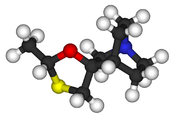Treatment Options for Dry Mouth
Many of my patients have dry mouth in addition to dry eyes.
The best options for dry mouth treatment are below. They each have their risks so be sure to understand risks before taking them.
1. Pilocarpine.
2. Cevimeline
3. Interferon -α
Systemic Salivary Stimulation
The secretagogues (meaning medicines that increase your salivation) pilocarpine and cevimeline are both muscarinic agonists: they both increase in salivary output and decrease the feeling of oral dryness in patients who still have some salivary gland function.
Pilocarpine is a nonselective muscarinic agonist.
Cevimeline has a higher affinity for M1 and M3 muscarinic receptor subtypes which causes fewer cardiac and/or pulmonary side effects.
Common side effects of these medications include sweating, flushing, urinary urgency, headache, and gastrointestinal discomfort.
These side effects are common, but are rarely severe or serious.
Parasympathomimetics are contraindicated in patients with uncontrolled asthma, narrow-angle glaucoma (as these can cause angle closure and an acute attack of headache/eye pain, high eye pressure: I have seen this happen with pilocarpine but not cevimeline), or acute iritis and should be used with caution in patients with significant cardiovascular disease, Parkinson’s disease, asthma, or chronic obstructive pulmonary disease. The best-tolerated doses for pilocarpine are 5 to 7.5 mg, given three or four times daily.
The duration of action is approximately 2 to 3 hours.
Cevimelineis currently recommended at a dosage of 30 mg three times daily; the duration of secretagogue activity is longer than pilocarpine (3 to 4 hours), whereas the onset is somewhat slower.
In contrast to the United States, Canada, and Japan, cevimeline is not yet licensed in Europe.
Interferon-α has been tried via the oromucosal route but some studies showed it may not work as well as the above two. Furthermore, flu-like side effects and high costs make this way of treatment less attractive.
Cevimeline
This is a medication some of my patients says helps their dry mouth from Sjögren’s syndrome. The biggest risk is angle closure risk due to the mechanism of action. I have not seen anyone have this from this medication but it can happen.
SLC
 |
|
 |
|
| Clinical data | |
|---|---|
| Trade names | Evoxac |
| AHFS/Drugs.com | Monograph |
| MedlinePlus | a608025 |
| Pregnancy category |
|
| Routes of administration |
By mouth (capsules) |
| ATC code | |
| Legal status | |
| Legal status |
|
| Pharmacokinetic data | |
| Protein binding | <20% |
| Identifiers | |
| CAS Number | |
| PubChem CID | |
| DrugBank | |
| ChemSpider | |
| UNII | |
| KEGG | |
| ChEBI | |
| ChEMBL | |
| Chemical and physical data | |
| Formula | C10H17NOS |
| Molar mass | 199.31308 g/mol |
| 3D model (JSmol) | |
| |
|
Cevimeline (trade name Evoxac) is a parasympathomimetic and muscarinic agonist,[1] with particular effect on M1 and M3 receptors. It is used in the treatment of dry mouth and especially associated with Sjögren’s syndrome.
Mechanism of action[edit]
By activating the M3 receptors of the parasympathetic nervous system, cevimeline stimulates secretion by the salivary glands, thereby alleviating dry mouth.
Side effects[edit]
Known side effects include nausea, vomiting, diarrhea, excessive sweating, rash, headache, runny nose, cough, drowsiness, hot flashes, blurred vision, and difficulty sleeping.[2]
See also[edit]
- Pilocarpine — a similar parasympathomimetic medication for dry mouth (xerostomia)
- Bethanechol — a similar muscarinic parasympathomimetic with longer-lasting effect
References:

